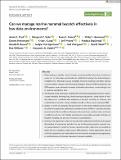Files in this item
Can we manage marine mammal bycatch effectively in low-data environments?
Item metadata
| dc.contributor.author | Punt, André E. | |
| dc.contributor.author | Siple, Margaret C. | |
| dc.contributor.author | Francis, Tessa B. | |
| dc.contributor.author | Hammond, Phil S. | |
| dc.contributor.author | Heinemann, Dennis | |
| dc.contributor.author | Long, Kristy J. | |
| dc.contributor.author | Moore, Jeff | |
| dc.contributor.author | Sepúlveda, Maritza | |
| dc.contributor.author | Reeves, Randall R. | |
| dc.contributor.author | Sigurðsson, Guðjón Már | |
| dc.contributor.author | Víkingsson, Gísli | |
| dc.contributor.author | Wade, Paul R. | |
| dc.contributor.author | Williams, Rob | |
| dc.contributor.author | Zerbini, Alexandre N. | |
| dc.date.accessioned | 2021-03-01T15:30:21Z | |
| dc.date.available | 2021-03-01T15:30:21Z | |
| dc.date.issued | 2021-01-03 | |
| dc.identifier | 271640842 | |
| dc.identifier | a19ebff6-4cf7-4e5c-8fb0-1a642f97130c | |
| dc.identifier | 85099056089 | |
| dc.identifier | 000604241800001 | |
| dc.identifier.citation | Punt , A E , Siple , M C , Francis , T B , Hammond , P S , Heinemann , D , Long , K J , Moore , J , Sepúlveda , M , Reeves , R R , Sigurðsson , G M , Víkingsson , G , Wade , P R , Williams , R & Zerbini , A N 2021 , ' Can we manage marine mammal bycatch effectively in low-data environments? ' , Journal of Applied Ecology , vol. Early View . https://doi.org/10.1111/1365-2664.13816 | en |
| dc.identifier.issn | 0021-8901 | |
| dc.identifier.other | RIS: urn:43118C86CD4AA1412A5CDD2E9481AA8F | |
| dc.identifier.other | ORCID: /0000-0002-2381-8302/work/90111703 | |
| dc.identifier.uri | https://hdl.handle.net/10023/21532 | |
| dc.description | Funding: Support for this project was provided by the Lenfest Ocean Program. | en |
| dc.description.abstract | 1. Determining acceptable rates of human‐caused mortality in low‐data situations is a concern for many taxa world‐wide. An established approach for determining acceptable levels of human‐caused mortality of marine mammals and other species of conservation concern is the Potential Biological Removal (PBR) framework, but PBR requires near‐unbiased estimates of absolute abundance, constraining its use in systems with limited data. 2. We develop three alternative methods for identifying acceptable levels of human‐caused mortality for long‐lived, slowly reproducing species, using indices of relative abundance combined with estimates of bycatch mortality in fisheries, and evaluate these methods using simulations similar to those used to develop PBR. 3. Across a variety of scenarios, the parameters of the three methods can be tuned to achieve conservation performance similar to that of PBR in scenarios that represent nearly ideal conditions. However, these methods produce lower and more variable bycatch mortality limits, depend upon reasonably accurate estimates of bycatch mortality and are more sensitive to uncertainties. 4. Synthesis and applications. Here we develop three alternative methods that expand the toolbox of approaches available for use in determining marine mammal conservation reference points for human‐caused mortality when it is not possible to apply the more standard, data‐hungry PBR approach. These approaches may be useful in supporting the establishment of new bycatch management programmes, or until estimates of absolute abundance become available. | |
| dc.format.extent | 12 | |
| dc.format.extent | 998975 | |
| dc.language.iso | eng | |
| dc.relation.ispartof | Journal of Applied Ecology | en |
| dc.subject | Bycatch limits | en |
| dc.subject | Fishery interactions | en |
| dc.subject | Low data | en |
| dc.subject | Marine mammal | en |
| dc.subject | Mortality | en |
| dc.subject | Potential Biological Removal | en |
| dc.subject | QH301 Biology | en |
| dc.subject | DAS | en |
| dc.subject | SDG 3 - Good Health and Well-being | en |
| dc.subject | SDG 14 - Life Below Water | en |
| dc.subject.lcc | QH301 | en |
| dc.title | Can we manage marine mammal bycatch effectively in low-data environments? | en |
| dc.type | Journal article | en |
| dc.contributor.institution | University of St Andrews. Sea Mammal Research Unit | en |
| dc.contributor.institution | University of St Andrews. Marine Alliance for Science & Technology Scotland | en |
| dc.contributor.institution | University of St Andrews. Scottish Oceans Institute | en |
| dc.contributor.institution | University of St Andrews. Centre for Research into Ecological & Environmental Modelling | en |
| dc.contributor.institution | University of St Andrews. School of Biology | en |
| dc.identifier.doi | 10.1111/1365-2664.13816 | |
| dc.description.status | Peer reviewed | en |
This item appears in the following Collection(s)
Items in the St Andrews Research Repository are protected by copyright, with all rights reserved, unless otherwise indicated.

